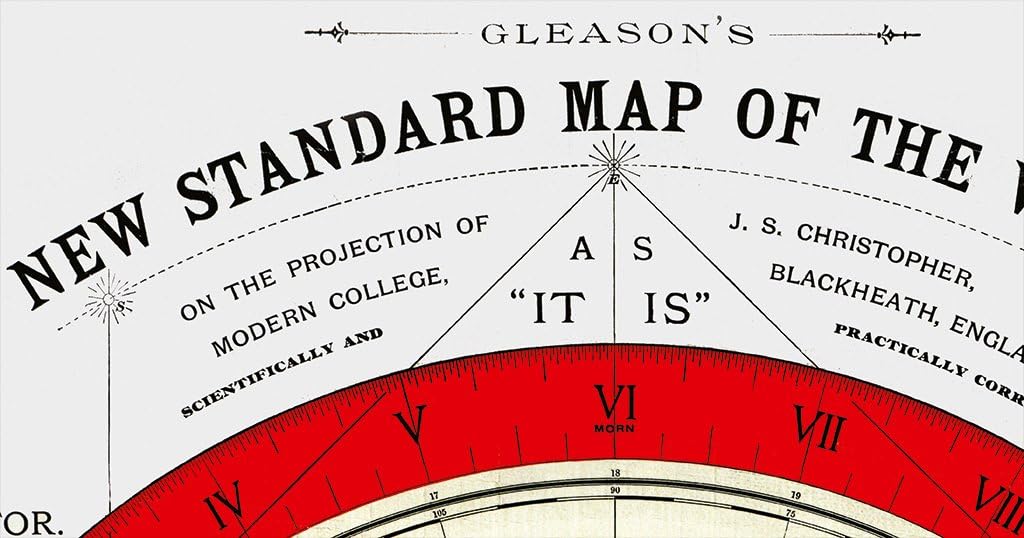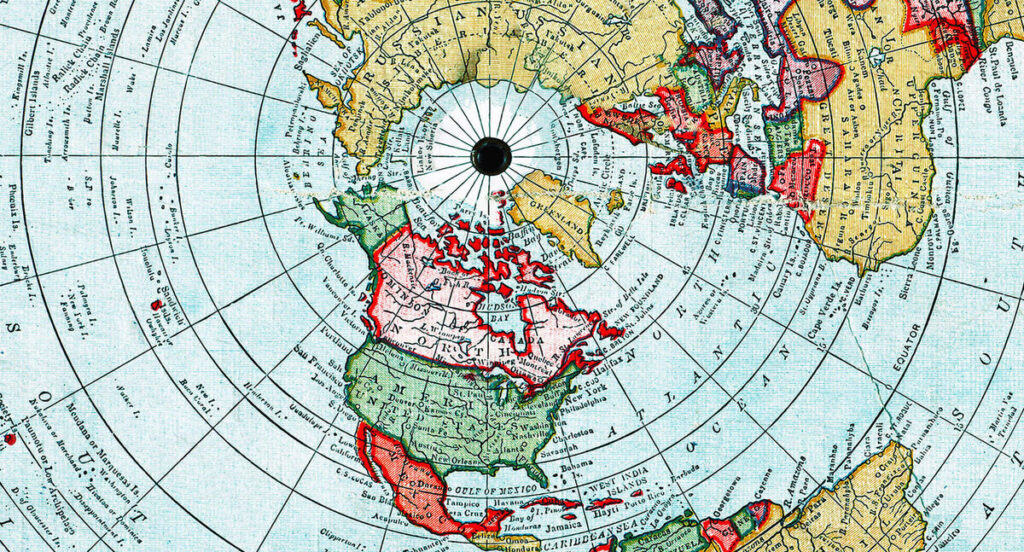
The Gleason Flat Earth Map: A Fascinating Relic of Alternative Cartography
The Gleason Flat Earth Map is a curious and often misunderstood artefact in the history of cartography. Created by Alexander Gleason in the late 19th century, this map presents a unique perspective on the world, one that aligns with the beliefs of the Flat Earth Society and challenges the conventional understanding of global geography.
While modern science overwhelmingly supports the spherical model of the Earth, the Gleason Map remains a compelling subject for those interested in alternative theories, historical cartography, and the psychology of belief systems.

The Origins of the Gleason Flat Earth Map
Alexander Gleason, a patent medicine salesman and inventor from New York, published his “New Standard Map of the World” in 1892. Gleason was a staunch advocate of the flat Earth theory, a belief that dates back to ancient civilisations but had largely been discredited by the time of the Enlightenment. His map was designed to support the idea that the Earth is a flat disc, with the North Pole at its centre and Antarctica forming an impenetrable ice wall around the circumference.
Gleason’s map is often referred to as an “azimuthal equidistant projection,” a type of map that preserves distances and directions from a central point.
While this projection is mathematically sound and is still used today (for example, in the United Nations logo), Gleason’s interpretation of it was unconventional. He claimed that his map was the “true” representation of the Earth, arguing that the spherical model was a conspiracy perpetuated by scientists and governments to deceive the public.
Design and Features of the Gleason Map
The Gleason Flat Earth Map is visually striking. It places the North Pole at the centre, with lines of longitude radiating outward like the spokes of a wheel. The continents are arranged in a circular fashion, with the southernmost regions—such as South America, Africa, and Australia—curving around the edge of the disc. Antarctica is depicted as a massive ring of ice encircling the Earth, acting as a barrier that prevents the oceans from spilling off the edge.
One of the most intriguing aspects of the Gleason Map is its attempt to reconcile the flat Earth model with observable phenomena, such as time zones and the apparent movement of the sun. Gleason argued that the sun orbits above the flat Earth in a circular path, creating day and night as it moves closer to or farther from specific regions. This explanation, while imaginative, fails to account for many well-established principles of astronomy and physics, such as the Coriolis effect and the changing positions of stars in the night sky.
Despite its scientific shortcomings, the Gleason Map has a certain aesthetic appeal. Its symmetrical design and radial layout make it visually distinct from traditional world maps, and its bold rejection of mainstream geography has earned it a place in the annals of alternative cartography.
The Cultural Significance of the Gleason Map
The Gleason Flat Earth Map is more than just a historical curiosity; it is a symbol of humanity’s enduring fascination with alternative worldviews. In an age when scientific consensus overwhelmingly supports the spherical Earth model, the persistence of flat Earth theories—and the continued interest in maps like Gleason’s—speaks to the power of scepticism and the allure of countercultural ideas.
For many, the Gleason Map represents a rejection of authority and a desire to question established norms. In this sense, it can be seen as part of a broader tradition of dissent and nonconformity. However, it also highlights the dangers of misinformation and the challenges of combating pseudoscience in the digital age. The internet has provided a platform for flat Earth proponents to share their views and attract followers, often using the Gleason Map as a visual aid to support their arguments.
The map’s cultural significance is further amplified by its association with conspiracy theories. Flat Earth theories often intersect with other fringe beliefs, such as distrust of government institutions, scepticism of mainstream media, and a general sense of disillusionment with modern society. For some, the Gleason Map is not just a representation of the world but a metaphor for a deeper truth that has been hidden from the masses.
The Gleason Map in Contemporary Discourse
In recent years, the Gleason Flat Earth Map has experienced a resurgence in popularity, thanks in part to the rise of social media and online communities dedicated to alternative theories. Flat Earth conferences, YouTube channels, and forums have brought the map back into the public eye, often presenting it as evidence of a vast conspiracy to conceal the “true” nature of the Earth.
This renewed interest has sparked debates about the role of education and critical thinking in combating misinformation. While the flat Earth theory has been thoroughly debunked by scientists, its persistence raises important questions about how knowledge is constructed and disseminated in the digital age. The Gleason Map serves as a reminder that even the most outlandish ideas can gain traction if they resonate with people’s fears, doubts, and desires for meaning.
At the same time, the Gleason Map has also found a place in popular culture. It has been featured in television shows, documentaries, and even video games, often as a symbol of eccentricity or a plot device in stories about secret societies and hidden truths. This cultural appropriation has further cemented the map’s status as an iconic representation of alternative worldviews.
The Psychology of Belief in the Gleason Map
The enduring appeal of the Gleason Flat Earth Map can be partly explained by the psychology of belief. Humans are naturally inclined to seek patterns and meaning in the world around them, and this tendency can sometimes lead to the acceptance of ideas that defy empirical evidence. The flat Earth theory, with its emphasis on hidden truths and secret knowledge, taps into this cognitive bias, offering a sense of certainty and control in an increasingly complex and uncertain world.
Moreover, belief in the Gleason Map and the flat Earth theory often involves a form of identity construction. For many flat Earth proponents, rejecting the spherical Earth model is not just about geography but about asserting their independence and individuality. By aligning themselves with a marginalised and controversial viewpoint, they can position themselves as free thinkers and truth-seekers, standing apart from the “sheeple” who accept mainstream narratives without question.
Conclusion: The Gleason Map as a Mirror of Human Curiosity
The Gleason Flat Earth Map is a fascinating artefact that reflects humanity’s enduring curiosity and capacity for imagination. While it may lack scientific validity, it serves as a powerful reminder of the diversity of human thought and the complex interplay between belief, evidence, and identity. In a world where information is increasingly abundant but not always reliable, the Gleason Map challenges us to think critically about the sources of our knowledge and the stories we choose to believe.
Whether viewed as a historical oddity, a symbol of dissent, or a cautionary tale about the dangers of misinformation, the Gleason Flat Earth Map continues to captivate and provoke. Its legacy is a testament to the enduring power of maps—not just as tools for navigation but as mirrors of our deepest fears, hopes, and questions about the world we inhabit.

